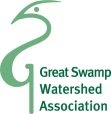 |
| The headwaters of Primrose Brook, one of the 5 major streams of the Great Swamp Watershed, rises inside the Jockey Hollow Unit of Morristown National Historical Parl. |
Most Americans remember the plight of ill-equipped Revolutionary War soldiers at Pennsylvania’s Valley Forge Encampment during the harsh winter of 1777-1778. As young children, we learn the story of patriots who starved, froze, and, marched without shoes; and those imagined scenes stick with us for the rest of our lives.
Fewer realize that an even worse season of snow and bone-chilling wind awaited those same troops only two year later. In 1779-80, while General George Washington pondered the British stronghold in New York City, he needed a place to camp the bulk of his Continental Army. He chose Jockey Hollow for his encampment—an area of land situated between Mendham and Morristown in New Jersey—and it was there that his men began digging in for what would become the coldest winter on record.
Despite the prospect of bad weather, the landscape in and around Jockey Hollow offered several advantages. The surrounding hills were militarily defensible. Proximity to the British and land routes in out of New York offered a perfect base for observation and spy missions. And an abundance of natural resources—clean water, wood cover, and fuel—meant a better chance for soldiers to survive winter’s oncoming wrath.
While more than 1.2 million Americans visit the national park at Valley Forge each year, only 300,000 or so visit Morristown National Historical Park annually. It was at Jockey Hollow that Washington’s troops honed their ability to endure, and it was this trait of the soldiery that became one of the keystone strategies that ultimately won the nation’s independence. How unfortunate is it that more of us—especially those of us living nearby—are so unfamiliar with this story of persistence, dedication, and patriotism?
The Great Swamp Watershed Association and Morristown National Historical Park will work together this June to spread the word about these heroes from our past. And part of the retelling of that story will focus on how a Revolutionary-era soldier’s relationship with the outdoors helped him and his comrades survive to march and fight.
On Sunday, June 9, from 10 a.m. to noon, join representatives from both partner groups for Jockey Hollow Explorers: Water and the Revolutionary War. Start the morning with a stroll through the history and the natural history of the Jockey Hollow encampment. You will learn more about how soldiers used natural resources—especially water—at the site and what condition those resources are in today.
Following the hike, meet a National Park Service interpreter for some hands-on activities. Water, in the 18th century, served not only in cooking and washing but also as a source of power, as a highway, a moat and even a dump. Learn about the role of water in daily life in the 18th century as well as the role of oceans and rivers in the American Revolution. Join the Park ranger in a role-playing game in which the adults represent England and the kids become the Patriots using waterways to defend their homeland.
This is a free event is open to all who wish to attend. Online registration in advance of attendance is strongly encouraged. Register by visiting the Great Swamp Watershed Association at GreatSwamp.org. To register via telephone, please call and leave a message at 973-538-3500 x22.
The Jockey Hollow Unit of Morristown National Historical Park is located at approximately 600 Tempe Wick Road in Morristown, NJ.
For more information about Morristown National Historical Park, please visit www.NPS.gov/morr. For more information about the Great Swamp Watershed Association, please visit GreatSwamp.org.



No comments:
Post a Comment